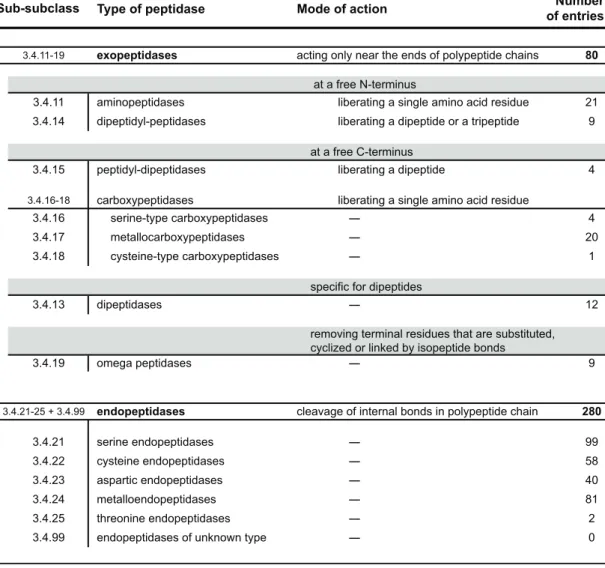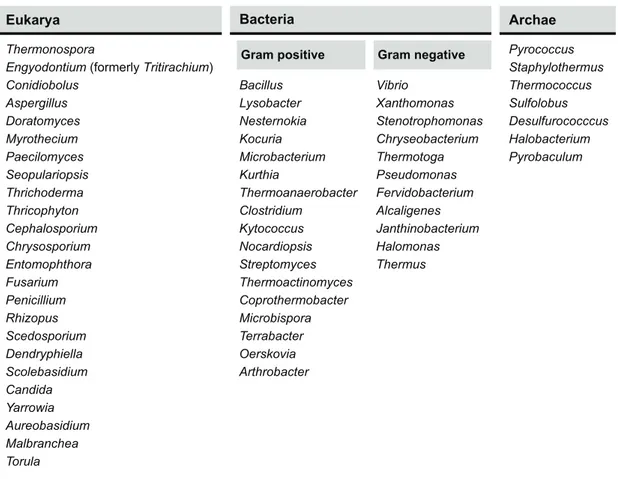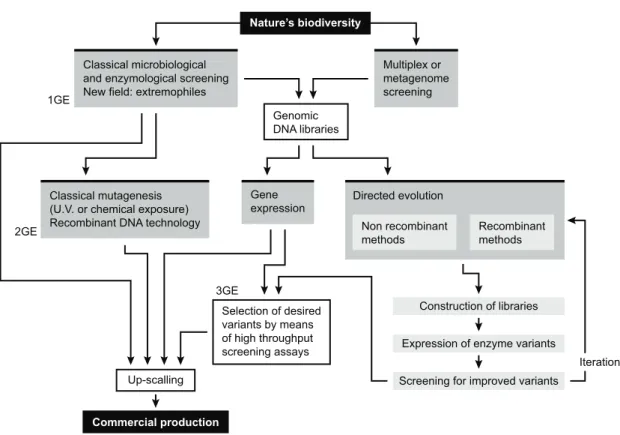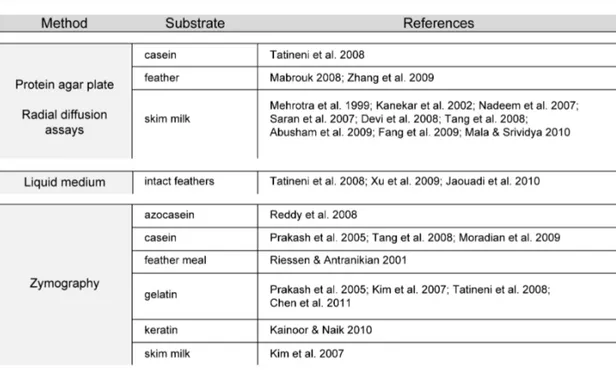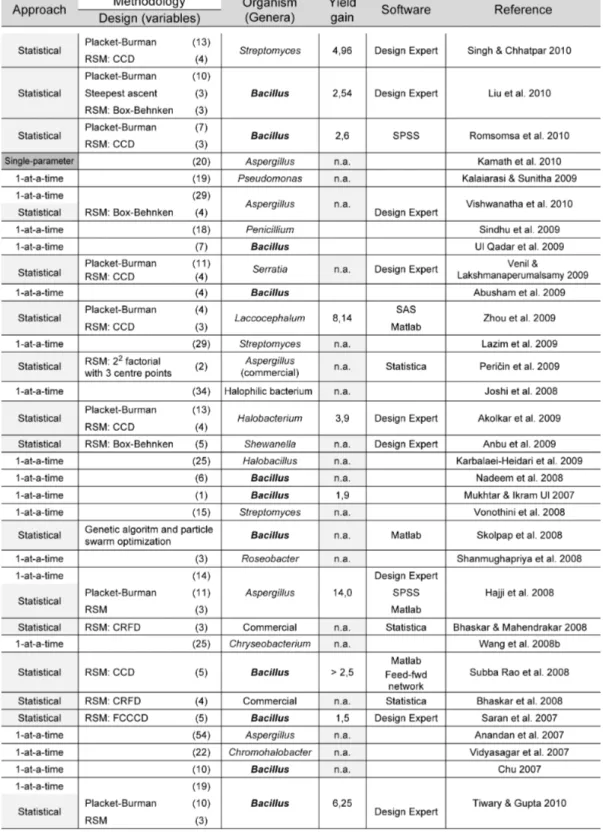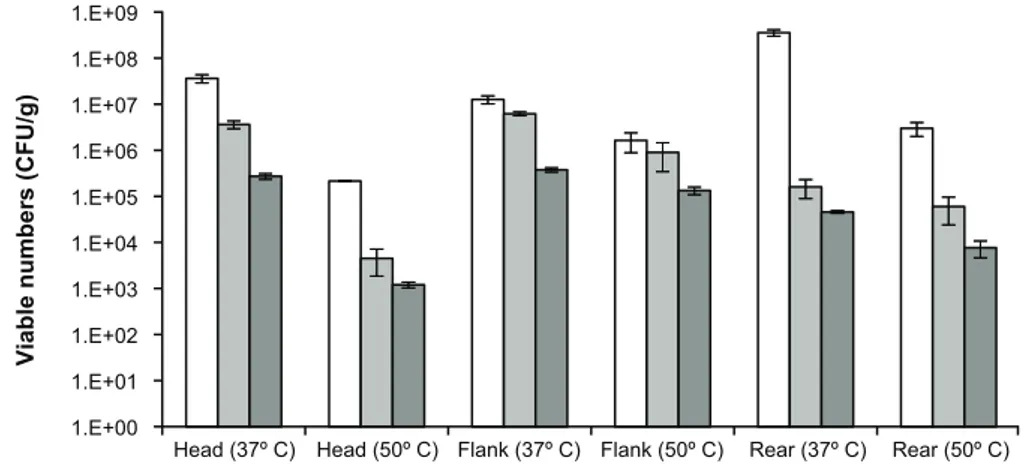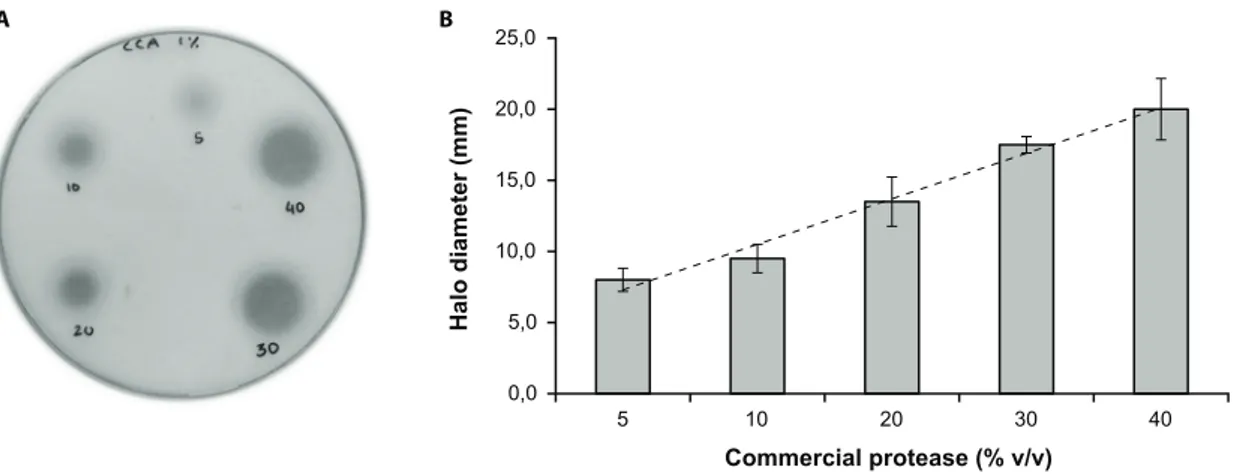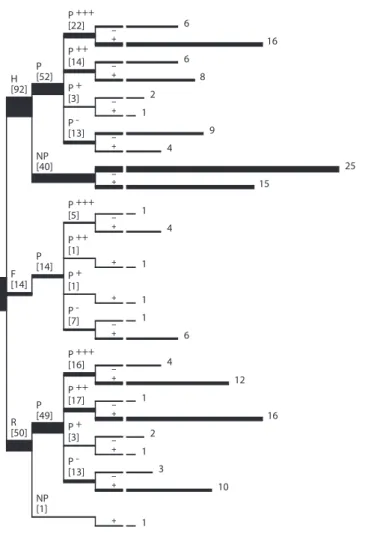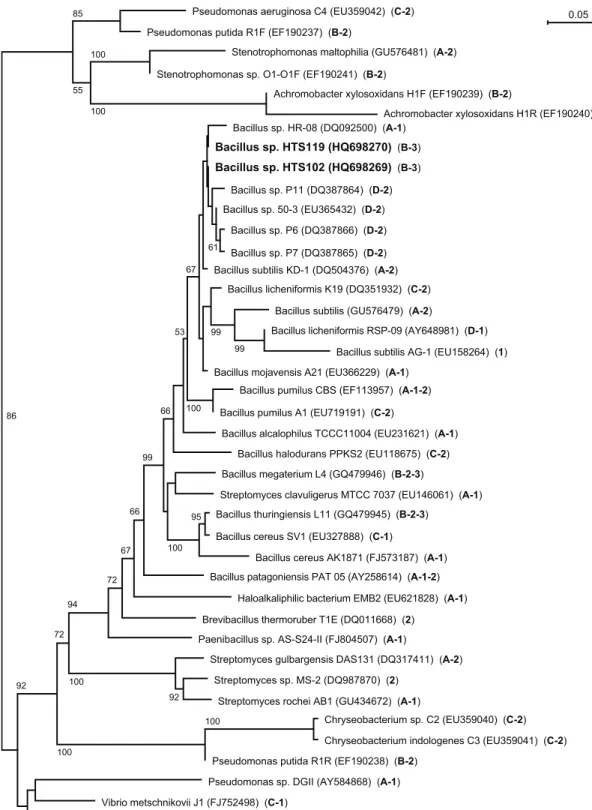Universidade Técnica de Lisboa
ORIENTADOR:
Doutor Francisco Xavier Delgado Domingos Antunes Malcata CO-ORIENTADOR:
Doutora Maria da Glória Calado Inglês Esquível JÚRI
Presidente:
Reitor da Universidade Técnica de Lisboa Vogais:
Doutor Francisco Xavier Delgado Domingos Antunes Malcata, professor catedrático do Instituto Superior da Maia, Porto
Doutor Luís Manuel dos Anjos Ferreira, professor catedrático da Faculdade de Medicina Veterinária da Universidade Técnica de Lisboa
Doutor Artur Cavaco-Paulo, professor associado da Escola de Engenharia da Universidade do Minho Doutora Maria da Glória Calado Inglês Esquível,
professora auxiliar do Instituto Superior de Agronomia da Universidade Técnica de Lisboa
Doutora Maria Luísa Lopes de Castro e Brito, professora auxiliar do Instituto Superior de Agronomia da Universidade Técnica de Lisboa Doutora Lígia Maria de Oliveira Martins, professora auxiliar convidada do Instituto de Tecnologia
NOVEL WILD BACTERIAL ENZYMES
FOR APPLICATIONS IN THE WOOL
INDUSTRY
TESE APRESENTADA PARA OBTENÇÃO DO GRAU DE DOUTOR EM BIOLOGIA
Ana Catarina Gonçalves Carvalho Queiroga Santos
LISBOA
Instituto Superior de Agronomia
NOVEL WILD BACTERIAL ENZYMES FOR APPLICATIONS
IN THE WOOL INDUSTRY
TESE APRESENTADA PARA OBTENÇÃO DO GRAU DE DOUTOR EM BIOLOGIA
ORIENTADOR: Doutor Francisco Xavier Delgado Domingos Antunes Malcata CO-‐ORIENTADOR: Doutora Maria da Glória Calado Inglês Esquível
JÚRI
Presidente:
Reitor da Universidade Técnica de Lisboa
Vogais:
Doutor Francisco Xavier Delgado Domingos Antunes Malcata, professor catedrático do Instituto Superior da Maia, Porto;
Doutor Luís Manuel dos Anjos Ferreira, professor catedrático da Faculdade de Medicina Veterinária da Universidade Técnica de Lisboa;
Doutor Artur Cavaco-‐Paulo, professor associado da Escola de Engenharia da Universidade do Minho;
Doutora Maria da Glória Calado Inglês Esquível, professora auxiliar do Instituto Superior de Agronomia da Universidade Técnica de Lisboa;
Doutora Maria Luísa Lopes de Castro e Brito, professora auxiliar do Instituto Superior de Agronomia da Universidade Técnica de Lisboa;
Doutora Lígia Maria de Oliveira Martins, professora auxiliar convidada do Instituto de Tecnologia Química e Biológica da Universidade Nova de Lisboa.
Ana Catarina Gonçalves Carvalho Queiroga Santos
LISBOA 2011
To Ginja, Rui and ZéZé, who taught me how to live curious.
Acknowledgements
Developing a PhD is a true marathon event – and I would not have been able to successfully complete this quest and conquer this academic achievement without the effort, support and collaboration of a countless number of people – who followed my work, and motivated and helped me in so many different ways over the latest years. It is, therefore, a great pleasure (and even honor) to hereby acknowledge them.
I must first express my gratitude to Escola Superior de Biotecnologia (ESB), for receiving me as a graduate student and providing me with good lab premises to perform a major part of my research, as well as promoting my participation in scientific meetings. I also acknowledge Instituto Superior de Agronomia, for taking me as a PhD student at a later stage of my program, and providing me with the necessary conditions to finalize my thesis and defend it.
My sincere gratitude goes obviously to Prof. F. Xavier Malcata, my supervisor from the very beginning, for his consistent and strong enthusiasm, for his everlasting motivation and for his extensive and strict scientific guidance. His recognized leadership, unique support, attention to detail, hard work and vast culture have all set an example for me and all those that have worked under his guidance. I keep reminding what he once told me: “Catarina, why do you think not everyone gets a PhD? – If getting advanced training were as simple as “following the basics”, everyone would surely achieve it” surprisingly, this has helped me put things in perspective over the last years – after all, perspective is the essence, and only someone with his intellectual status would give me such a seminal advice. I acknowledge him for understanding and helping me strive in my multidisciplinary approach, and for trusting me – so that, despite a number of troubling features along the way, I would be able to focus on the essentials, and hence finish up my project successfully. I would also like to thank him for proposing me such great challenges as helping in the organization of National Scientific Meetings, and in the edition of a national peer-‐reviewed journal – those experiences really made a difference in my early career, in stimulating my learning and structuring my growth. I also acknowledge Dr. Glória Esquível, my co-‐supervisor, for having accepted me and reviewed my thesis. To Prof. F. Xavier Malcata and Dr. Glória Esquível, I am indeed grateful for the promptness in providing suggestions to improve my thesis, despite their many professional commitments.
I would like to express my gratitude to Dr. Manuela Pintado, for her continuous operational support during my research path at ESB, and to Dr. Ana Gomes, for her prompt
availability and guidance to solve unexpected problems, irrespective of the topic. For their kindness and friendship, and their special care in setting a good working environment during the years I spent there (I still remember all the moments of joy, especially in Badajoz, and the very many “birthday-‐cake party” in our offices) – for all that, I thank them.
A particularly special recognition to Dr. Paula Tamagnini, from Instituto de Biologia Molecular e Celular (IBMC), for the availability to receive me in her lab where I was able to perform an important part of my experimental work, as well as for all the specific and technical support made available in terms of molecular biology issues – it was indeed a pleasure to work in said lab. I also acknowledge her sustained friendship, continuous motivation and insightful advices. Likewise, I am grateful to Prof. Pedro Moradas Ferreira, from IBMC, for always treating me as if I were part of his research group, and for his wise advice that made a difference early after my graduation.
I acknowledge financial support from Fundação para a Ciência e Tecnologia (SFRH/BD/19212/2004), granted for development of this PhD project, and for complementary participation in international scientific meetings – where I presented my results, and was able to learn from international experts (who so often offered interesting feedback and valuable suggestions). In particular, I acknowledge Fundação Calouste Gulbenkian for granting me a fellowship to present an invited oral communication at an international scientific meeting held in South Korea.
Orlanda Martins, my favorite “doctor” at ESB, deserves a special mention: she inspired me because of her professionalism and commitment to work. I would like to thank her for being so supportive and positive – about work, and about life in general, and for all the effort she put forth to ensure I had all required consumables and reagents on time, so as not to delay my experiments.
I am also indebted to Escola Profissional de Economia Social (epESaJMS), where I have been working for the last 4 years, for the opportunity to grow both as a professional and as a person; this experience has been fantastic, and made a difference in my education by helping me face many of the PhD project difficulties in a more positive manner. Finishing writing of my thesis would ultimately have not been possible if its Directors, namely Fernando Martinho, Justino Santos and Lucília Alves, had not believed in my capacity to efficiently couple pedagogic management and finalization of a research project – I thank them wholeheartedly, for their everlasting support and friendship, and for providing me the chance to prove they were right.
I could not pass without showing my sincere appreciation for the effort of many school collaborators, to help relief my professional burden via their dynamism and competence – particularly Ana Sá, David Alves and Paula Marques. To the other collaborators and teachers at epESaJMS, I thank them for allowing me – via increasing their dedication and commitment to epESaJMS vision and mission, to reduce the need for permanent monitoring.
My recognition also goes:
To Ana Ferreira, Camino Fontan, Catarina Barbosa, Joana Teodósio and Sérgio Maia, with whom I had the pleasure to share the lab benches since the very beginning of my research program, and who helped me develop a critical judgment throughout such a “simple” task of thinking about the world as I see it and confronting it with the perception by others.
To Susana Miranda, for helping to run the lab smoothly, and for assisting me in so many different ways – her contribution and dedication surely allowed me to focus better on my research project, and certainly less on lab management tasks.
To my dear “senior” researcher fellows, namely Ana Paula Carvalho, Freni Tavaria and Susana Caldas, for providing a stimulating and fun environment that aided to learn and progress.
To Alison Machado, Simone Abrunhosa and Manuel Teibão, who have contributed to my work in the scope of their undergraduate courses.
To my many colleagues and friends, within the research groups which I had the pleasure to work with – Ana Amaro, Ana Catarina Guedes, Ana Ferreira, Ana Figueiredo, Ana Pintado, André Borges, Camino Fontan, Catarina Barbosa, Catarina Guedes, César Rodrigues, Cláudia Pereira, Ivone Moreira, Isabel Franco, Joana Carvalho, Joana Inácio, Joana Odila, Joana Teodósio, João Fernandes, Lígia Pimentel, Manuela Amorim, Maria Gião, Óscar Ramos, Patrícia Moreira, Patrícia Reis, Raquel Branquinho, Raquel Madureira, Ricardo Pereira, Sérgio Maia, Sérgio Sousa, Tânia Tavares, Teresa Braga, Vanessa Ralha, Vânia Figueira and Vicenza Ferraro from ESB; and Ângela, Catarina Pacheco, Daniela, Filipe, Patrícia Cardoso, Pedro, Sara and Zille from IBMC. Each of them helped make the time invested in this PhD project more fun and interesting. I also acknowledge the enjoyable lunches together at University cantina and “D. Júlia”.
To Manu, João, Sérgio, Tânia and Vanessa, for their companionship during many nights and weekends spent on the lab.
Throughout my life, I have been fortunate to come across with so many funny and good friends, without whom life would have been void and dull. I would like to thank them all for distracting me joyously, and for the constant reminder that there are more important things in life than only a PhD thesis.
To Ana Ferreira, Sérgio Maia and Vanessa Ralha, I thank all the “after-‐work” parties – it was sometimes exactly what I needed after a day spent fighting with data (or absence thereof).
To Joana Inácio, Isabel Franco and César Rodrigues, for their friendship and ever-‐present support, and with whom I could always have a great chat (regardless of subject).
To Tânia Tavares, for inspiring me with her strong personality and continuous search for happiness. I thank her for the long telephone calls about science (and others), especially during the thesis-‐writing period – when we were physically far away from each other. To Catarina Pacheco, Daniela, Filipe, Marta, Paula Tamagnini, Pedro and Sara, for sharing so many happy moments, namely great summer gatherings at Prof. Pedro Moradas Ferreira’s home, during our great and challenging canyoning adventure and several dinner parties.
To Júlio Cabral, Miguel Polónia and Susana Pedro – my friends for life, for the huge amounts of laughing and unconditional sharing.
Finally, I would like to express my gratitude to my closest family for providing me with a loving environment to.
To Fernando and Lucília, I thank the love, support, entertainment and comradeship made available during so many weekday dinners spent together.
To my mom, for instilling me with a drive for the PhD pursuit and to my dad, for showing me that art is everywhere and is available to anyone who is open to learn from it – this really assisted me in so many different ways. Ginja and Zézé, you raised me, supported me, taught me and loved me – I thank you from the bottom of my heart, for your continuous and unconditional support. From the thesis-‐writing period, you can be sure I will retain for life the memories of our weekends – “invariably” spent together at home
with our laptops: Ginja hitting hard on her keyboard, Rui working hard on his PhD with his headphones always on and high, Zézé checking his colorful and funny e-‐mails, and Tarzan Babayaga (our “Prince of the White Russia”) always sleeping in the couch.
To Rui, my life companion, my friend, my lover: I am grateful for the sharing of so many happy moments, and for helping me through so many difficult times – for his sustained emotional support, love and caring. Throughout the writing of this thesis, you provided me encouragement, sound advices, crisis support during a few “brain” meltdowns, good teaching, excellent company and lots of good ideas. I would have been lost without you.
Título da tese: Novas enzimas bacterianas para aplicação na indústria dos lanifícios
Resumo
A investigação descrita nesta dissertação foi desenvolvida com o objectivo de desenvolver processos enzimáticos para aplicação na indústria dos lanifícios, através da pesquisa de novas atividades enzimáticas produzidas por estirpes bacterianas isoladas de amostras de lã crua – recolhida de 3 zonas distintas do corpo de ovelhas Merino Portuguesa.
De entre os 156 isolados, 115 mostraram possuir atividade proteolítica, dos quais foram selecionados os dois apresentando atividades proteolíticas superiores – 24.6 and 15.9 U/mL, e identificados como Bacillus sp. HTS 102 e
Bacillus sp. HTS 119. Os sobrenadantes livres de células desses dois isolados
foram testados sobre malha de lã, no intuito de avaliar o seu potencial efeito benéfico sobre as características da fibra – tendo sido usadas força de rebentamento, perda de peso e área de encolhimento como parâmetros quantitativos, enquanto que a análise da microestrutura por microscopia electrónica de varrimento foi utilizada como parâmetro qualitativo.
Qualquer bioprocesso industrial requer uma cuidada optimização das condições de processamento para ser economicamente viável. Como os dois isolados anteriormente referidos causaram menores perda de peso e área de encolhimento do que as registadas usando uma enzima comercial (como referência), sob idênticas condições de processamento – e sem perdas significativas na força de rebentamento, o isolado apresentando maior
produtividade proteolítica (i.e. Bacillus sp. HTS 102) foi selecionado para os ensaios de otimização de síntese de proteases. Após uma pesquisa inicial dos parâmetros mais relevantes com efeito sobre a referida síntese, foi aplicado um planeamento factorial fraccionado do tipo 2VI6-‐1 para determinar os efeitos da
concentração de extracto de levedura, do nível de peptona, do tamanho do inóculo, da taxa de agitação, da temperatura e do pH. Este ensaio preliminar revelou que 4 factores (i.e. extracto de levedura, peptona, temperatura e pH) desempenham papéis importantes, e que existe uma interação relevante entre a concentração de extracto de levedura e o pH. A influência desses 4 factores sobre a produtividade de protease(s) foi então investigada através de um planeamento factorial completo (24), juntamente com metodologias de resposta de superfície.
O modelo polinomial de segunda ordem sugerido mostrou-‐se adequado para prever a síntese de protease(s) (R2=0.944, P<0.01), sendo que a atividade
máxima atingida foi de 56.8 U/mL – o que traduz uma mais que duplicação da atividade registada em meio basal.
A protease extracelular sintetizada pelo Bacillus sp. HTS 102 foi caracterizada bioquimicamente, a par da avaliação da sua capacidade para ser usada na formulação de detergentes – bem como a de funcionar como ferramenta no tratamento anti-‐encolhimento de artigos de lã. Considerando os bons resultados obtidos em termos de estabilidade e atividade na gama de pH 7-‐ 9, bem como de estabilidade adequada em relação a agentes tensioativos e oxidantes, conclui-‐se que a protease produzida por aquela estirpe é uma boa candidata para os referidos detergentes – que são concebidos para boa eficiência a baixas temperaturas de lavagem. Peças de malha de lã tratadas com extracto enzimático de Bacillus sp. HTS 102 mostraram melhorias significativas nas suas
características físico-‐químicas – designadamente molhabilidade e grau de suavidade aumentados, a par de baixa área de encolhimento e perda de força aceitável.
Por fim, dos 115 isolados proteolíticos, 5 estirpes bacterianas capazes de degradar a lã foram selecionadas pelas suas notáveis atividades queratinolíticas. As estirpes selecionadas foram identificadas como pertencentes ao género
Bacillus; cresceram em meio com penas e lã (inteiras e trituradas); e foram
capazes de os hidrolisar, bem como em meio contendo cabelo e unhas – embora nestes últimos o grau de hidrólise tenha sido inferior. Estes resultados revelam a possibilidade da sua utilização no aproveitamento e valorização de desperdícios sólidos ricos em queratina, incluindo a preparação de rações animais.
Palavras-‐chave: novas estirpes, lã, enzima proteolítica, queratinase,
caseínase, anti-‐feltragem, encolhimento, planeamento experimental factorial fraccionado, metodologia de resposta de superfície, biodegradação.
Abstract
The research reported in this thesis was aimed at developing enzyme-‐ based processes for application in the wool industry, via screening novel enzyme activities from wild bacterial strains isolated directly from raw wool samples – collected at distinct parts of healthy Portuguese Merino sheep.
Among the 156 isolates obtained, 115 exhibited proteolytic activity, and 2 were eventually chosen owing to their particularly high proteolytic activities – 24.6 and 15.9 U/mL, and identified as Bacillus sp. HTS 102 and Bacillus sp. HTS 119. The cell-‐free supernatants of the isolates exhibiting the best performance were tested on knitted wool, to assess their potential beneficial role upon fiber features – viz. bursting strength, weight loss and area shrinkage were used as quantitative parameters, whereas microstructure via scanning electron microscopy was used as qualitative parameter.
Economically feasible industrial bioprocesses require in general careful preliminary optimization of processing conditions. Since the aforementioned isolates produced lower weight loss and area shrinkage than those brought about by a commercial enzyme (used as reference), under similar operating conditions – and without significantly compromising bursting strength, the isolate exhibiting the best proteolytic performance in basal medium (i.e. Bacillus
sp. HTS 102) was selected for exploratory optimization of protease synthesis. After preliminary screening for the most relevant factors affecting protease synthesis, a 2VI6-‐1 fractional factorial design was applied to ascertain the effects
of yeast extract concentration, peptone level, inoculum size, stirring rate, temperature and pH. This preliminary optimization attempt revealed that 4 factors (i.e. yeast extract, peptone, temperature and pH) played significant roles, as well as a 2-‐factor interaction between yeast extract level and pH. The influence of said factors upon protease productivity was further investigated via a 24 full factorial, central composite design, coupled with a response surface
methodology. The empiric second-‐order model postulated was adequate to predict protease productivity (R2=0.944, P<0.01); the maximum protease activity
attained was 56.8 U/mL – i.e. more than twice that exhibited in the basal medium.
The (crude) extracellular protease synthesized by Bacillus sp. HTS 102 was biochemically characterized – with special care toward assessment in detergent formulation, and as a tool in attempts to increase the shrink-‐resistance of woolen fabrics. Considering its good activity and stability in the pH range 7-‐9, and its relative good stability to surfactants and oxidizing agents, the protease(s) produced by said strain is an interesting candidate for formulation of detergents intended for efficiency at low washing temperatures. Woven wool fabrics treated with crude enzyme from Bacillus sp. HTS 102 exhibited noticeable improvements in their fabric features – viz. increased wettability and softness degree, together with low area shrinkage and acceptable strength loss.
Finally, among the 115 proteolytic isolates, five wool-‐degrading bacterial strains were selected because of their noteworthy keratinolytic activity. All said
five strains, belonging once again to the genus Bacillus, were able to grow and hydrolyze feathers and wool (both native and milled), and hair and nails to a lesser extent. A potential for upgrading keratin-‐rich solid wastes was thus unfolded, including animal feed formulation.
Keywords: novel strains, wool, proteolytic enzyme, keratinase, caseinase,
anti-‐felting, shrinkage, fractional factorial design, response surface methodology, biodegradation.
Scope and Outline
This PhD dissertation is organized in chapters – each divided in one or two sections, which parallel the progress of my research. The sections are related to each other, and the methodology chosen in each section was (unsurprisingly) dependent on the conclusions conveyed in previous one(s).
Most work described hereby encompasses screening and optimization of a novel bacterial proteolytic enzyme, suitable for industrial applications in the wool industry. Additionally, the need to assess the applicability of such an enzymatic system to wool processing led to tuning of several technical tests.
In Chapter 1 – “General Introduction”, an overview of current and novel approaches is conveyed, encompassing the search for novel proteolytic enzymes aimed at textile and agro-‐industrial applications.
Attempts to find novel bacterial sources, originating in raw Portuguese Merino wool, and able to produce proteolytic enzyme(s) suitable for application in (selected) textile processes, are described in Chapter 2. The methodology followed and the results obtained for isolation, selection and identification of bacterial isolate(s) with desired proteolytic activities are described in Section
2.1 – whereas Section 2.2 pertains to preliminary assessment of enzyme
To be of industrial/commercial interest, an enzyme should to advantage be excreted to high levels or its rate of production optimized. After isolation, selection and identification of the best bacterial source of protease, synthesis of said enzyme was optimized using several approaches (Chapter 3): Section 3.1 describes the preliminary optimization of several nutritional and processing factors affecting protease production based on one-‐at-‐a-‐time and fractional factorial design approaches, whereas use of a central composite design and response surface methodology to optimize protease synthesis by a novel strain of Bacillus sp. is described in Section 3.2.
Several additional tests for assessment of (crude) enzyme applicability for wool processing, as well as its biophysical characterization were conducted as detailed in Chapter 4: while Section 4.1 relates to the potential applications of the protease in wool processing and laundry, Section 4.2 focuses on the potential use of said protease(s) for biodegradation of keratinous materials.
Final remarks are presented in Chapter 5, which is divided in “General Conclusions” and “Future Perspectives” – as Section 5.1 and Section 5.2, respectively.
Most information provided in the 9 sections of this thesis has been already submitted to international peer reviewing, via publication in international scientific journals – as detailed bellow:
Chapter 1
Queiroga, A.C., Pintado, M.E. & Malcata, F.X. (2012) “Search for novel proteolytic enzymes aimed at textile and agro-‐industrial applications: an overview of current and novel approaches”, Biocatalysis and Biotransformation 30: 154-‐169
Soares, J.C., Moreira, P.R., Queiroga, A.C., Malcata, F.X. & Pintado, M.E. (2011) “Application of immobilized enzyme technologies for the textile industry: a review”, Biocatalysis and Biotransformation 29: 223-‐237
Chapter 2
Queiroga, A.C., Pintado, M.E. & Malcata, F.X. (2011) “Wool-‐associated proteolytic bacteria, isolated from the Portuguese Merino breed”, Enzyme and Microbial Technology [submitted]
Queiroga, A.C., Pintado, M.M. & Malcata, F.X. (2007) “Novel microbial-‐mediated modifications in wool”, Enzyme and Microbial Technology 40:1491-‐1495
Chapter 3
Queiroga, A.C., Pintado, M.E. & Malcata, F.X. (2011) “Processing for maximum extracellular protease productivity by Bacillus subtilis HTS 102 – a novel wild strain isolated from Portuguese Merino Wool”, Applied Microbiology and Biotechnology [submitted]
Queiroga, A.C., Pintado, M.E. & Malcata, F.X. (2011) “Use of response surface methodology to optimize protease synthesis by a novel strain of Bacillus sp., isolated from Portuguese sheep wool”, Biochemical Engineering Journal [submitted]
Chapter 4
Queiroga, A.C., Pintado, M.E. & Malcata, F.X. (2011) “Protease from a novel Bacillus strain: potential industrial application in wool processing and laundry”, Journal of Industrial Microbiology and Biotechnology [submitted]
Queiroga, A.C., Pintado, M.E. & Malcata, F.X. (2012) “Potential use of wool-‐associated Bacillus species for biodegradation of keratinous substrates”, International Biodeterioration and Biodegradation 70: 60-‐65
TABLE OF CONTENTS
DEDICATION ... V ACKNOWLEDGMENTS ... VII RESUMO ... XI ABSTRACT ... XV SCOPE AND OUTLINE ... XIX
TABLE OF CONTENTS ... XXIII
CHAPTER 1
GENERAL INTRODUCTION ... 1
Section 1.1
Search for novel proteolytic enzymes aimed at textile and agro-‐industrial
applications: an overview of current and novel approaches ... 3
1.1.1. Abstract ... 3
1.1.2. Introduction ... 4
1.1.3. Types and sources of proteolytic enzymes ... 6
1.1.4. Search for novel systems – classical and improved approaches ... 13
1.1.4.1 Biocatalyst screening ... 13
1.1.4.2 Biocatalyst engineering ... 15
1.1.5. Peptidase assays ... 16
1.1.5.1 Qualitative and semi-‐quantitative methods ... 18
1.1.5.2 Quantitative methods ... 21
1.1.6. Production of proteases ... 22
1.1.6.1 Fermentation processes ... 23
1.1.7. Purification of proteases ... 25
1.1.8. Industrial impact of enzyme technology ... 28
1.1.8.1 Textile processing and agro-‐industrial applications ... 29
1.1.8.2 Protease-‐based wool finishing and hide-‐dehairing ... 29
1.1.8.3 Protease-‐based laundry detergents ... 31
1.1.8.4 Protease-‐based processing of keratin-‐rich wastes ... 32
1.1.9. Constraints on large-‐scale applicability of proteases ... 32
1.1.10. Final considerations ... 34
1.1.11. References ... 34
CHAPTER 2
SCREENING FOR BACTERIA PRODUCING SUITABLE PROTEASE ... 55 Section 2.1
Isolation, selection and identification of a bacterial isolate with high proteolytic activity 57 2.1.1. Abstract ... 57 2.1.2. Introduction ... 58 2.1.3. Materials and Methods ... 60 2.1.3.1. Sampling of fleece ... 60
2.1.3.2. Enumeration and isolation of bacteria ... 61
2.1.3.3. Purification and preliminary characterization of isolates ... 62
2.1.3.4. Preliminary assay for proteolytic activity ... 62
2.1.3.5. Screening for best protease producers ... 64
2.1.3.6. Molecular characterization of selected isolates ... 65
2.1.3.7. Phylogenetic analysis of selected isolates ... 66
2.1.4. Results ... 67 2.1.4.1. Enumeration and isolation of bacteria ... 67
2.1.4.2. Preliminary assay for proteolytic activity ... 69
2.1.4.3. Screening for best protease producers ... 69
2.1.4.4. Molecular characterization of best isolates ... 71
2.1.4.5. Phylogenetic analysis of selected isolates ... 73
2.1.5. Discussion ... 73 2.1.6. References ... 80 Section 2.2
Preliminary assessment of enzyme applicability for wool processing ... 83 2.2.1. Abstract ... 83 2.2.2. Introduction ... 84 2.2.3. Materials and Methods ... 86 2.2.3.1. Microorganisms sources ... 86
2.2.3.3. Protein content assay ... 87
2.2.3.4. Proteolytic activity assays ... 87
2.2.3.5. Wool finishing assays ... 89
2.2.3.6. Statistical analysis ... 92
2.2.4. Results and Discussion ... 92 2.2.5. Conclusions ... 98 2.2.6. References ... 99
CHAPTER 3
OPTIMIZATION OF PROTEASE PRODUCTION AND ACTIVITY
... 101
Section 3.1Nutritional and processing factors affecting protease productivity by
Bacillus sp. HTS 102 ... 103
3.1.1. Abstract ... 103 3.1.2. Introduction ... 104 3.1.3. Materials and Methods ... 107 3.1.3.1 Preliminary screening via “one-‐factor-‐at-‐a-‐time” approach ... 107
3.1.3.2 Optimization via 2VI6-‐1 fractional factorial design approach ... 108
3.1.3.3 Fermentation conditions ... 109
3.1.3.4 Protease activity assay ... 109
3.1.3.5 Protein content assay ... 110
3.1.3.6 Data statistical analysis ... 110
3.1.4. Results ... 111 3.1.4.1 Carbon/nitrogen source selection ... 111
3.1.4.2 Significant physicochemical parameter determination ... 111
3.1.4.3 Nutrient broth constituent effects ... 112
3.1.4.4 Optimization via 2VI6-‐1 fractional factorial design ... 116
3.1.5. Discussion ... 118 3.1.5.1 Significant physicochemical parameters ... 119
3.1.5.2 Optimization via 2VI6-‐1 fractional factorial design ... 122
3.1.6. References ... 124 Section 3.2
Optimization of protease synthesis via central composite design and response
surface methodology ... 127 3.2.1. Abstract ... 127 3.2.2. Introduction ... 128 3.2.3. Materials and Methods ... 130 3.2.3.1 Curvature of starting polynomial model ... 130
3.2.3.3 Microorganism source and fermentation conditions ... 131
3.2.3.4 Protease activity assay ... 132
3.2.3.5 Protein content assay ... 132
3.2.3.6 Statistical analyses ... 132
3.2.4. Results and Discussion ... 134 3.2.4.1 Parameter interaction and curvature ... 134
3.2.4.2 Response surface analysis ... 136
3.2.4.3 Validation of model ... 140
3.2.5. Conclusions ... 141 3.2.6. References ... 142
CHAPTER 4
ASSESSMENT OF PROTEASE APPLICABILITY IN WOOL INDUSTRY:
LABORATORY-‐SCALE STUDIES
... 145
Section 4.1Potential applications of protease from Bacillus sp. HTS 102 in wool processing
and laundry ... 147 4.1.1. Abstract ... 147 4.1.2. Introduction ... 148 4.1.3. Materials and Methods ... 150 4.1.3.1 Source of microbial enzyme ... 150
4.1.3.2 Growth of, and enzyme production by microorganism ... 151
4.1.3.3 Assays for protease activity and protein content ... 151
4.1.3.4 Effects of surfactants and oxidants upon protease stability ... 152
4.1.3.5 Effects of enzyme inhibitors and metal ions upon protease activity ... 152
4.1.3.6 Effects of pH and temperature upon protease activity and stability ... 153
4.1.3.7 Tests of protease in wool processing ... 153
4.1.3.8 Tests of protease in laundry detergents ... 156
4.1.4. Results ... 157 4.1.4.1 Effects of surfactants and oxidants upon protease activity ... 157
4.1.4.2 Effects of enzyme inhibitors and metal ions upon protease activity ... 158
4.1.4.3 Effects of pH and temperature upon protease activity and stability ... 158
4.1.4.4 Tests of protease in wool processing ... 160
4.1.4.5 Tests of protease in laundry detergents ... 161
4.1.5. Discussion ... 162 4.1.6. Conclusions ... 167 4.1.7. References ... 168
Section 4.2
Potential use of wool-‐associated Bacillus species for biodegradation of
keratinous materials ... 173 4.2.1. Abstract ... 173 4.2.2. Introduction ... 174 4.2.3. Materials and Methods ... 176 4.2.3.1 Selection of microorganisms ... 176
4.2.3.2 Identification of microorganisms ... 176
4.2.3.3 Performance in submerged fermentation ... 177
4.2.3.4 Assay for extent of degradation ... 178
4.2.3.5 Assay for enzyme activity ... 178
4.2.3.6 Effects of processing conditions ... 179
4.2.4. Results ... 179 4.2.5. Discussion ... 185 4.2.6. Conclusions ... 186 4.2.7. References ... 187 CHAPTER 5 FINAL REMARKS
... 191
Section 5.1 Concluding Remarks ... 193 Section 5.2 Future Prospects ... 197 CHAPTER 6 REFERENCES... 199
Chapter 1
Section 1.1
Search for novel proteolytic enzymes aimed at textile and agro-‐
industrial applications: an overview of current and novel
approaches
1.1.1. Abstract
Types and sources of proteolytic enzymes, assays commonly used for proteases, strategies for protease yield-‐improvements, and novel proteases and applications in industrial sectors are covered in this review, in a balanced and critical manner – with an emphasis on alkaline proteases employed in the textile and detergent industries, and on degradation of keratin-‐rich wastes thereby. Current constraints pertaining to industrial applicability of these enzymes, and tentative solutions to be pursued are highlighted as well.
1.1.2. Introduction
Proteolytic enzymes are ubiquitous in terms of occurrence; they are found in all living organisms, and are essential for cell growth and differentiation. Although protease production is an inherent feature of the Earth biota, only those producing substantial amounts of extracellular protease(s) have been exploited commercially (Gupta et al. 2002b); and microorganisms – especially strains of Bacillus sp., dominate the industrial sector at present (Fujinami & Fujisawa 2010; Rao et al. 1998).
Various isolation methods have been described and discussed that enable screening and selection of promising organisms for industrial production; in addition, there are many possibilities for modifying biocatalysts through molecular approaches. For instance, strain improvement using mutagenesis and/or recombinant DNA technology has been applied to magnify the efficiency of producer strains to commercially feasible forms. Search for microbial sources of novel alkaline proteases within the natural biodiversity – using metagenomic approaches, has also unfolded a wide molecular diversity (Gupta et al. 2002b). These fascinating developments will eventually allow the biotechnological exploitation of uncultured microorganisms, which outnumber by far the species accessible by cultivation (regardless of their source habitat).
To develop efficient enzyme-‐based processes suitable for industry, prior knowledge of various fermentation parameters, purification strategies and properties of the biocatalyst itself are of the utmost importance. Furthermore, the method of assay for proteolytic performance – including selection of
substrate and analytical protocol, depends on the ultimate industrial application. A large array of assays are indeed available in the literature; however, with the advent of molecular approaches aimed at producing better biocatalysts, less conventional substrates and assay protocols have become increasingly important – chiefly those that can be conducted at micro/nano-‐scale (Gupta et al. 2002a).
Fermentation of proteases is usually mastered by varying the C/N ratio, and the presence and level of metabolizable sugars, e.g. glucose; successful scale-‐ up has been attained using fed-‐batch, continuous and chemostat approaches, via extending the stationary phase of the culture (Joshi et al. 2008). Conventional purification strategies encompass concentration by bulk chromatographies, or aqueous two-‐phase systems (solid/liquid via precipitation, or liquid/liquid via solvent extraction).
Keratinases form a unique group of proteolytic enzymes; they display the ability to degrade (the insoluble protein) keratin, and have accordingly become important since they bring about hydrolysis of the highly rigid, strongly cross-‐ linked structural polypeptides in keratin – which is a well-‐known recalcitrant to most proteases (Gupta & Ramnani 2006). Such enzymes are often produced in the presence of keratinous substrates, e.g. hair, feather, wool, nail and horn, either milled or intact; they form a class of particularly robust enzymes, with wide temperature and pH activity ranges – and most are serine-‐ or metallo-‐ proteases. Sequence homologies exhibited by keratinases have indeed indicated their relatedness to the subtilisin family (Adıgüzel et al. 2009).
The aforementioned enzymes stand out among proteases because they can attack keratin wastes – hence finding applications in cost-‐effective feather
by-‐product upgrading, toward feed and fertilizer formulations. Their application can also be extended to the detergent and leather industries, where they serve as specialty enzymes (Gupta & Ramnani 2006); and they also find uses in wool and silk cleaning, whereas their enhanced dehairing potential has led to development of greener hair-‐saving and dehairing technology in the leather industry, as well as of personal care products in the cosmetic industry.
1.1.3. Types and sources of proteolytic enzymes
As detailed by the Nomenclature Committee of the International Union of Biochemistry and Molecular Biology (NC-‐IUBMB), all existing enzymes are divided into six distinct classes: oxidoreductases, transferases, hydrolases, lyases, isomerases and ligases. Proteolytic enzymes (or peptidases, a synonymous term recommended by NC-‐IUBMB) constitute a class of hydrolases – and are defined as enzymes that can hydrolyze peptide bonds, thus forming a distinct subclass, EC 3.4.
Recall that a further two sets of sub-‐subclasses of peptidases are recognized: those of exopeptidases (EC 3.4.11-‐19), which act only near either terminus of a polypeptide chain; and endopeptidases (EC 3.4.21-‐24 and EC 3.4.99), which act preferentially away from those termini; a comprehensive account of this classification is provided in Table 1.1.1. Hence, peptidases are not classified purely on the basis of the reactions they catalyze, but also based on their catalytic type. As a consequence, different proteins can be regarded as distinct peptidases, even when they express similar or identical peptidase activities (Beynon & Bond 2001).
Table 1.1.1 – The EC system of classification of peptidases. Adapted from Beynon & Bond (2001), updated with data available at www.chem.qmul.ac.uk/iubmb/enzyme, on March 2011)
Besides the type of reaction catalyzed and the chemical nature of the catalytic site, a third classification criterion has been proposed – MEROPS, in attempts to group peptidases according to a criterion that reflects essential structural features, and evolutionary relationships referred to those structural features (Rawlings et al. 2010). In the MEROPS system, each peptidase is assigned to a family on the basis of statistically significant similarities in its amino acid sequence; and families thought to be homologous are in turn grouped together in a clan (Rawlings et al. 2010). A more detailed description of the
Type of peptidase Mode of action
exopeptidases 80 3.4.11 aminopeptidases 21 3.4.14 dipeptidyl-peptidases 9 3.4.15 peptidyl-dipeptidases 4 3.4.16-18 carboxypeptidases 3.4.16 serine-type carboxypeptidases 4 3.4.17 metallocarboxypeptidases 20 3.4.18 cysteine-type carboxypeptidases 1 3.4.13 dipeptidases 12 3.4.19 omega peptidases 9 endopeptidases 280 3.4.21 serine endopeptidases 99 3.4.22 cysteine endopeptidases 58 3.4.23 aspartic endopeptidases 40 3.4.24 metalloendopeptidases 81 3.4.25 threonine endopeptidases 2
3.4.99 endopeptidases of unknown type 0
Sub-subclass
3.4.11-19
3.4.21-25 + 3.4.99
Number of entries
acting only near the ends of polypeptide chains at a free N-terminus
liberating a single amino acid residue liberating a dipeptide or a tripeptide at a free C-terminus
liberating a dipeptide
liberating a single amino acid residue
specific for dipeptides
removing terminal residues that are substituted, cyclized or linked by isopeptide bonds
intrinsic features of each peptidase sub-‐subclass was addressed elsewhere to some length (Rao et al. 1998; Beynon & Bond 2001).
Since peptidases are of a major physiological importance in all living organisms, they are found in nature at large (Rao et al. 1998). Owing to their metabolic, and consequently commercial importance, proteolytic enzymes have drawn the attention of researchers for quite some time – so there is a vast array of literature on the biochemical and biotechnological aspects of peptidases, including their animal, plant or microbial sources (Anwar & Saleemuddin 1998; Rao et al. 1998; Kumar & Takagi 1999; Niehaus et al. 1999; Demirjian et al. 2001; Gupta et al. 2002b; Antão & Malcata 2005; Gupta & Ramnani 2006; Dubey et al. 2007; Brandelli 2008; Klomklao 2008; Esposito et al. 2009; Brandelli et al. 2010; Fujinami & Fujisawa 2010).
Plant sources have conveyed many useful peptidases, viz. papain (Dubey et al. 2007), bromelain (Benucci et al. 2011) and ficin (Devaraj et al. 2008) – which have proven successful in medicine and food industry applications. Nevertheless, use of plants as sources of commercially relevant peptidases is typically constrained by availability of land for cultivation and suitability of weather conditions for growth (Rao et al. 1998). Moreover, production of proteases by plants is a time-‐consuming process (Rao et al. 1998), so it will hardly become economically feasible for applications requiring substantial amounts of said enzymes.
The most commonly studied peptidases of animal origin are gastrointestinal varieties, e.g. pepsin, trypsin, chymotrypsin and rennin (Klomklao 2008; Esposito et al. 2009; Mendes et al. 2009). These peptidases are prepared in pure form to large numbers, yet their production rate is critically
dependent on the availability of livestock for slaughter – which, in turn, is a direct function of political and agricultural policies, besides tightening ethical considerations (Rao et al. 1998).
Although proteolytic enzymes can be (and were originally) obtained from plants and animals, microorganisms are a much more favorable source if industrial applications are targeted – due to their much broader biochemical diversity, coupled with their susceptibility for genetic manipulation; additionally, they can be cultured to large amounts, require limited space for cultivation and regular supply can be assumed on a worldwide basis (Gupta et al. 2002b). The most convenient peptidase-‐producing microorganisms belong to three domains: Eukarya, Bacteria and Archae (Brandelli et al. 2010). These microorganisms have been isolated from the most distinct habitats on Earth, ranging from Antarctic soils (Marshall 1998) to hot springs (Pillai & Archana 2008), and from acidic (Yallop et al. 1997) to extremely alkaline environments (Singh et al. 1999; Genckal & Tari 2006) – besides both aerobic and anaerobic ecosystems; therefore, they are capable of producing proteolytic enzymes with biochemical features that allow similar environmental conditions to be used during processing, including ability to withstand harsh industrial setups. A number of reviews have detailed information on a comparative basis, and emphasized the microbial diversity among peptidase producers (Anwar & Saleemuddin 1998; Kumar & Takagi 1999; Niehaus et al. 1999; Gupta et al. 2002b; Haki & Rakshit 2003; Gupta & Ramnani 2006; Brandelli 2008; Brandelli et al. 2010); information on the most relevant genera is depicted in Table 1.1.2, especially pertaining to those proteolytic enzymes eventually more useful in textile and agro-‐industrial processing.
